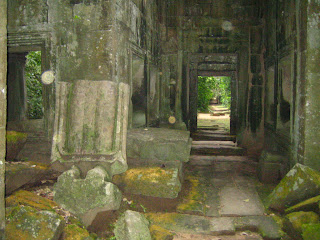Angkor: Our Favorites
Or: Pictures we haven't found an excuse to post yet
Joey’s Top Pick: Neak Pean
Neak Pean is composed of a central pond with four smaller ponds in the cardinal directions. In Joey’s words, it was a functional ritual device – or, it was a cool toy. Water was poured from from the center pool down a channel held by a figure, which emptied through the mouth of a separate figure into the smaller pool. Each of the side pools had a different figurehead; the human and elephant are by far the best preserved. There was no water in the pool on the day we visited but it was easy to imagine the site in use almost a thousand years ago.


Erin’s Top Pick: Banteay Samre
Banteay Samre is a very compact temple that contains similar elements to its much larger cousin, Angkor Wat, but on a much smaller scale. It was not the most spectacular, best preserved, or most interesting but it was the most peaceful. Fewer people visit Banteay Samre and the coziness of the temple (one doesn’t need to touch the ground to go between the staircase down from the outer enclosure to the staircase up to the central shrine) invites people to sit and relax.

Ta Prohm
Many of the memorable pictures of Angkor come from Ta Prohm, a temple preserved in a state of arrested decomposition. Ecole Francaise d’Extreme-Orient decided to leave Ta Prohm in its “natural state.” Much of the undergrowth has been cleared and dangerous walls propped up but the temple has mainly been left as it was found. It is easily the most romantic of the temples that we visited.


Preah Khan
We sat out a rainstorm in the enormous Preah Khan complex. It was originally built as a Buddhist University by Jayavarman VII. Through every door and window, there seems to be yet another room, hallway, or open space to explore. But for the rain, we could easily have wandered through its rooms for hours. We particularly liked the "where the wild things are" carvings on the pillars leading to the entrance.

Banteay Samre is a very compact temple that contains similar elements to its much larger cousin, Angkor Wat, but on a much smaller scale. It was not the most spectacular, best preserved, or most interesting but it was the most peaceful. Fewer people visit Banteay Samre and the coziness of the temple (one doesn’t need to touch the ground to go between the staircase down from the outer enclosure to the staircase up to the central shrine) invites people to sit and relax.

Ta Prohm
Many of the memorable pictures of Angkor come from Ta Prohm, a temple preserved in a state of arrested decomposition. Ecole Francaise d’Extreme-Orient decided to leave Ta Prohm in its “natural state.” Much of the undergrowth has been cleared and dangerous walls propped up but the temple has mainly been left as it was found. It is easily the most romantic of the temples that we visited.


Preah Khan
We sat out a rainstorm in the enormous Preah Khan complex. It was originally built as a Buddhist University by Jayavarman VII. Through every door and window, there seems to be yet another room, hallway, or open space to explore. But for the rain, we could easily have wandered through its rooms for hours. We particularly liked the "where the wild things are" carvings on the pillars leading to the entrance.




2 Comments:
ok one of those homages looks like a throne! (Erin, I know these are special and sacred to you...I don't mean any offense with my prattling, I just want to entertain. Please dont be offended.) Joey you can chuckle at these posts anytime. Love, Mare
and Joey I only say you could chuckle at my prattling because I know I could not offend you! You are an Austin! (no backlash allowed) the Austin's are a fine family (I mean that with all my heart, Mare
Post a Comment
<< Home